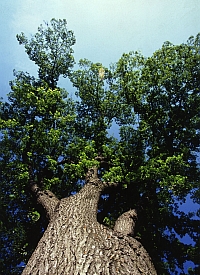Two U.S. Department of Agriculture (USDA) scientists believe they have found a missing variety of American elm tree with genes that carry resistance to Dutch elm disease. Botanist Alan Whittemore and geneticist Richard Olsen, with the USDA’s National Arboretum in Washington, D.C., will publish their findings in the April edition of the American Journal of Botany.
Dutch elm disease kills individual branches and eventually the entire tree within one to several years. American elms (Ulmus americana) are considered to be tetraploids, trees with four copies of each chromosome. Rumors of trees with three or two chromosome copies — triploids or diploids — have circulated among specialists, but have not been substantiated.
Whittemore and Olsen say they have proven that diploid American elms exist as a subset of elms in the wild. The discovery of the disease-tolerant Jefferson elm in 2005, a triploid, started the team on a search for a diploid in the wild that had crossed with a tetraploid to produce the triploid.
The two scientists tested elm trees from across the species’ eastern and central U.S. range. About 21 percent of the wild elms sampled were diploid, growing in stands with tetraploids or in larger groupings of diploids.
The authors say the small amount of genetic data now available suggests that at least some tetraploid and diploid elm populations have diverged significantly from one another, which strengthens the chance of the diploid trees having genes for disease resistance that tetraploids do not have.
American elms remain popular because of their beauty, rapid leaf litter decay, and ability to stand up to city air pollution. Elms are also an important tree crop for the $4.7 billion-a-year nursery industry, especially since very few new trees with tolerance to the disease have been introduced.
* * *


 RSS - Posts
RSS - Posts
You must be logged in to post a comment.